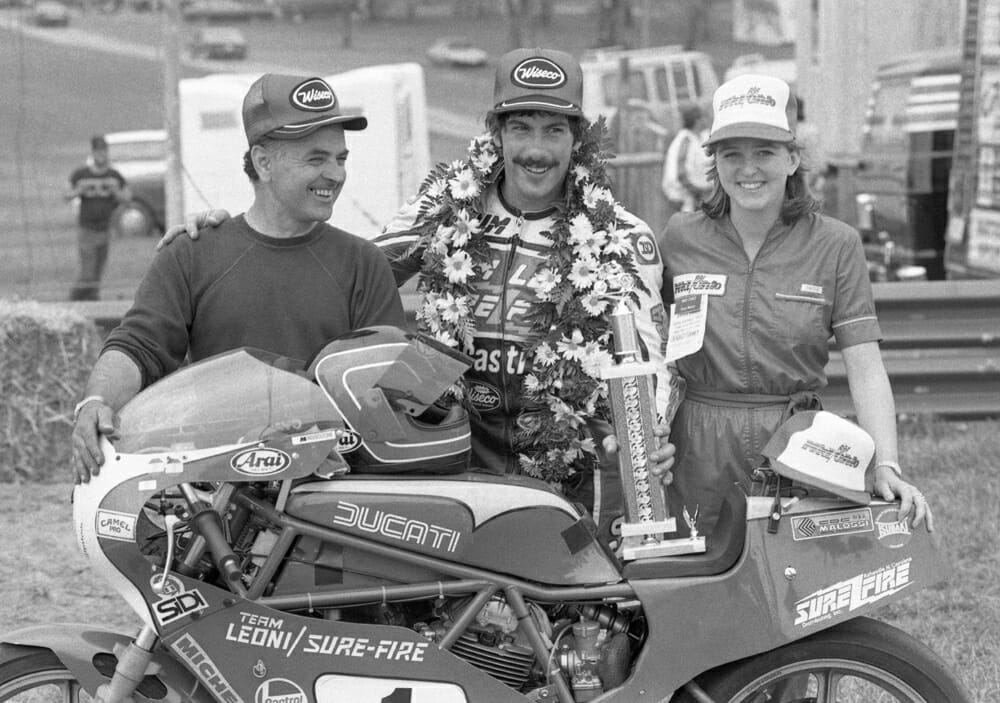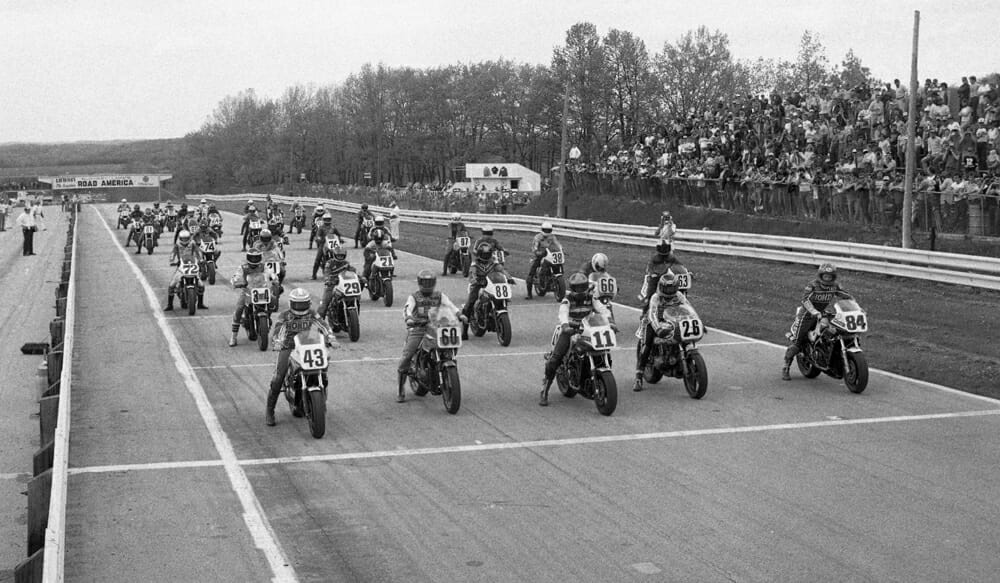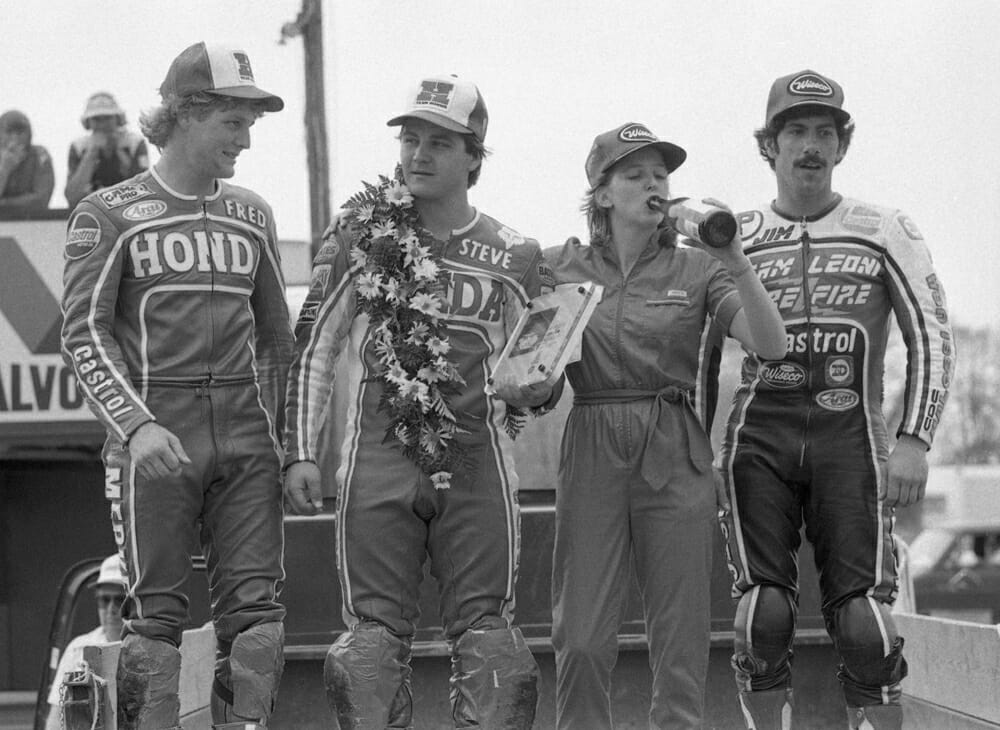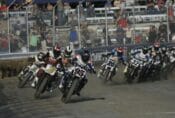Cycle News Archives
COLUMN
Superbike Underdogs Jimmy and Reno
In two seasons of Battle of the Twins racing Jimmy Adamo was the undisputed King. Racing the Reno Leoni-built Ducati, he won both the 1981 and ’82 Battle of the Twins Championships going away. So, after two seasons of running roughshod over the competition for two seasons, and at times being competitive in the AMA Superbike class, Adamo and Leoni decided to pump up the Ducati, which started life as a production 750SS, even more and put a little more focus in the Superbike class. The timing they felt was perfect with rules changes, which saw the big four-cylinder AMA Superbikes restricted to 750cc, down from the previous limit of 1025cc.

The teaming of Leoni with Adamo came by way of a recommendation of Mike Baldwin. Baldwin had been riding for Leoni in ’78 when he signed with Kawasaki. Leoni was looking for a new rider. The two were watching the novice race at Laguna Seca, where Adamo had a great ride, in spite of his bike losing a footpeg. Leoni asked Baldwin about Adamo.
“Mike told me that Jimmy was a good rider,” Leoni recalls. “And that he lived on Long Island, not too far from me in New Jersey. So, I talked to him that weekend and when we got home, I talked to Berliner, and they agreed, and then I had Jimmy come to the Berliner factory in New Jersey and we started our partnership.”
Berliner Motor Corp. was the U.S. distributor for Ducati and Moto Guzzi at the time. In ’79 Adamo raced his first Superbike races with Team Leoni, at first on the Moto Guzzi and later on a Ducati.
During its first year as a national championship, AMA Superbike racing was dominated by two-cylinder European motorcycles like the BMW, Moto Guzzi and Ducati. In fact, for the first season and a half, nothing other than a twin won an AMA Superbike race. But then came Reg Pridmore’s victory at Pocono in August of 1979 on a Kawasaki, quickly followed by Steve McLaughlin’s win on a Suzuki, and the flood gates were open. The Japanese 1000cc multis now had such a power advantage over the twins, that the days of winning Superbike races on a twin-cylinder machine were numbered.

Then in 1980 when Honda came into Superbike to do battle with Kawasaki and Suzuki, the twin-cylinder Superbikes that were winning races just a season or two before were suddenly obsolete. That’s when Jess O’Brien put Battle of the Twins together with help from the AMA, the Florida GP Riders’ Association and several other clubs. O’Brien knew there were a lot of late 1970s twin-cylinder Superbikes still around and he figured there would be plenty of riders and fans of the twins to launch a series for the bikes. He was right, the inaugural Battle of the Twins race at Daytona in 1981 was packed with entries and fans loved it. So much so that the after the first season of the class, which ran at most AMA road race nationals and more, it became an official AMA National Championship in ’82.
Adamo, riding the Leoni Ducati, won that first race at Daytona in ’81 and went on to when that first non-national BOTT Championship in ’81 and followed that up with another dominant season in the championship’s first AMA National designation in ’82. He would win it again in ’83, but that season Leoni thought with the new rules that Adamo might be able to do some damage in the Superbike class. They wouldn’t be able to do a full season because some of the Superbike rounds were Pro-Am events not featuring the BOTT class, where Adamo made his money.
One of Adamo’s biggest BOTT rivals, Malcolme Tunstall also raced Ducatis and noticed that Adamo’s Team Leoni/Sure-Fire Ducati showed up with numerous updates in ’83. He speculates that many of those were put in place to compete in Superbike.
“They were running wider wheels, full floater brakes, special bigger [diameter] forks, Fox was working with them on rear shocks, they had a special thin-tubing racing frame and the engine packing a lot of NCR performance modifications,” Tunstall said. “I would guess the bike was under 350 pounds and was making very close to 100 horsepower.”

While those number are impressive, consider the factory Honda Superbikes were producing 125-plus horsepower and probably weighed just under 400 pounds.
“Getting a top-10 finish on a Twin in Superbike back in that era was like winning the race,” Tunstall added.
In the Daytona Superbike race Adamo qualified a strong seventh. While that sounds decent, but not earth-shattering, consider this—the only riders to qualify faster were five factory or factory-backed Hondas (Mike Baldwin, Freddie Spencer, Steve Wise, Fred Merkel and David Aldana) and the factory Kawasaki of Wayne Rainey. Adamo qualified in front of Honda-support riders Roberto Pietri and Sam McDonald and the other factory Kawasaki of Wes Cooley!
In the race, Adamo was running in a group with Cooley and Merkel when his engine let go four laps into the race. While it didn’t end on a high note, the concept of racing the better handling, lighter Ducati against the four-cylinder Superbikes showed merit, even at the horsepower hungry Daytona International Speedway.
At Talladega, Adamo again was running among the factory bikes in seventh most of the race before experiencing problems and dropping to 11th at the finish. Since it was a Pro-Am and had no BOTT race, Adamo skipped the West Coast trip to the AMA Superbike round at Riverside. Then came the highlight of the season for Adamo in the AMA Superbike Championship that season. It was round four at Mid-Ohio.
Adamo used the quick handling of his Ducati to maximum advantage at Mid-Ohio and early on battled with Honda riders Fred Merkel and Sam McDonald. Then attrition among the leaders. Wes Cooley was out early with engine problems on his factory Kawasaki. Then Cooley’s teammate Wayne Rainey crashed. That left a Honda factory parade running up front with Mike Baldwin leading the way over Steve Wise, McDonald and Merkel. Adamo was next in the grouping with McDonald and Merkel.

Halfway through the race things settled a bit as Baldwin stretched his lead over Wise and Merkel and was gradually gapping Adamo. Fourth looked like a very respectable finish, but with about 10 laps to go Baldwin crashed out, putting Wise in the lead, Merkel second. Adamo suddenly had a podium in sight but also had a problem.
“I rode the final 10 or so laps with the transmission stuck in third,” Adamo later told Cycle News’ Gary Van Voorhis. “The shift lever fell off and there wasn’t anything I could do except hope that there wasn’t anyone close enough to pick me off.”
Adamo held on and earned the podium finish. It marked his career high AMA Superbike finish. It also marked the end of the early era of AMA Superbike. A twin-cylinder powered motorcycle would not score a series podium result for another six years.
Adamo would go on to score fourth at the expansive Road America and three more seventh-place finishes. Despite doing a very limited schedule Adamo finished ranked 10th in the final 1983 AMA Superbike point standings. Again, that was the last time a twin finished ranked inside the top 10 in AMA Superbike until 1989 when Dale Quarterley managed the feat on a Ferracci Ducati.
It was an outstanding performance by Adamo on what was by then an ancient bevel-drive Ducati. The combination of Adamo’s relentless drive to improve and Leoni’s ability to get the most horsepower, handling and reliability out of the old Ducati proved a highly competitive combo.
And as Enzo Assainte, who worked as Adamo’s mechanic in the early 1990s, points out, “Jimmy and Reno were running this effort with very little budget. Compare that to the millions Honda was spending at the time. For Jimmy to be able to regularly run with those guys is nothing short of a miracle.”
Over the years Leoni and Adamo became close friends. They even formed an import business together called Gio.Ca.Moto USA. Sadly, Adamo passed away in a crash at Daytona in 1993. Today, though, Leoni can look back with a smile on his face when he thinks about life on the racing circuit with Adamo.
“Jimmy and I argued all the time, but in a friendly way,” Leoni recalls with a laugh. “He used to start swerving on the highway acting like he was falling asleep so I would take over the driving. Or he would have fun flirting with girls in those early days and look at me with a big smile while he was talking with them. He was very serious when it came to his racing, but he knew how to have a good time too.”
And no question Leoni is proud of the BOTT wins and championships they won together, but even he admits it was especially fun to stick it to the factory Superbike teams every now and then.
“We were underdogs for sure, but sometimes we had a good bite!” CN
Click here to read the Archives Column in the Cycle News Digital Edition Magazine.
Subscribe to nearly 50 years of Cycle News Archive issues
